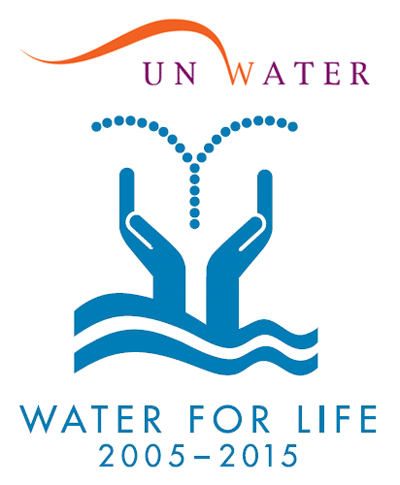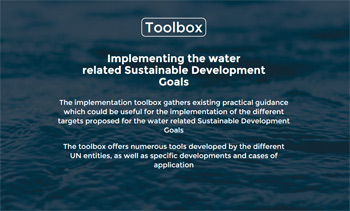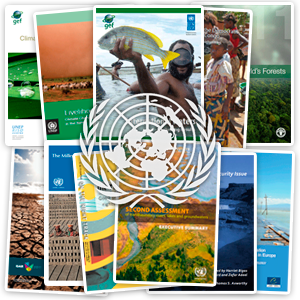- ON THE DECADE
- THE DECADE'S CAMPAIGN
- REPORTING ON PROGRESS
- THE DECADE'S PROGRAMMES
- FOCUS AREAS
-
- Access to sanitation
- Financing water
- Gender and water
- Human right to water
- Integrated Water Resources Management
- Transboundary waters
- Water and cities
- Water and energy
- Water and food security
- Water and sustainable development
- Water and the green economy
- Water cooperation
- Water quality
- Water scarcity
- FOCUS REGIONS
- RESOURCES FOR
- UN e-RESOURCES
Reporting on progress from Member States
The quantitative goals of the Decade encompass the Millennium Development Goal (MDG) target on water supply and the additional goals on sanitation and on water resources management agreed during the CSD meeting in Johannesburg. Reporting on country level results was initially limited to the WHO/UNICEF Joint Monitoring Programme (JMP) for Water Supply and Sanitation and the Commission on Sustainable Development (CSD) reporting process. Currently, the information to monitor progress on achieving these goals comes from the MDG progress report, the GLAAS report the JMP report, as well as the UN World Water Development Report.
The 2013 MDG Report shows that the MDG drinking water target was met 5 years ahead of schedule by halving the proportion of people without access to improved drinking water sources despite significant population growth. However, from 1990 to 2011, only 1.9 billion people gained access to a latrine, flush toilet or other improved sanitation facilities, it represents 64% of the global population. Therefore a strong push is needed to ensure that this number increases by another 1 billion people by 2015 to meet the MDG sanitation target.
UN monitoring and reporting system
Within the UN there is a series of documents providing information on water supply, sanitation and governance of water and water resources.
The 2008 UNDESA report on the Status of Implementation of CSD-13 Policy Actions on Water and Sanitation provided an analysis of water management by national governments, as it adjusted their activities for the level of their development, showing a potentially much fairer picture of their efforts. The report is an attempt to further the implementation agenda in the domain of water and sanitation. It is based on a survey carried out in 35 countries on the state of implementation of policy actions and measures relating to integrated water resources management, water supply and sanitation.
provided an analysis of water management by national governments, as it adjusted their activities for the level of their development, showing a potentially much fairer picture of their efforts. The report is an attempt to further the implementation agenda in the domain of water and sanitation. It is based on a survey carried out in 35 countries on the state of implementation of policy actions and measures relating to integrated water resources management, water supply and sanitation.
The WHO/UNICEF Joint Monitoring Programme (JMP) for Water Supply and Sanitation provides information on coverage of sanitation and water supply, combined with some additional information. The data from the JMP report were announced as 'a baseline for the Water for Life Decade', by the UN Secretary General in his report to the General Assembly in 2005. There is currently no special effort to highlight how the report is serving to track progress in the Water Decade. Specific programmes, like the initiative Sustainable Sanitation: The Drive to 2015 for sanitation are being explicitly tracked on their progress.
The UN-Water Global Annual Assessment of Sanitation and Drinking Water (GLAAS) report is another document that focuses at the country level. Its objective is to monitor the inputs required to extend and sustain water, sanitation and hygiene systems and services. This includes the components of the "enabling environment": documenting government policy and institutional frameworks; the volume, sources and targeting of investment; the sufficiency of human resources; priorities and gaps with respect to external assistance; and the influence of these factors on performance. A secondary goal is to analyse the factors associated with progress, or lack thereof, in order to identify drivers and bottlenecks, to identify knowledge gaps, to assess strengths and weaknesses, to identify challenges, priorities and successes, and to facilitate benchmarking across countries.
The AQUASTAT global information system at FAO has been collecting information on water resources and their use for a long time. The main mandate of the programme is to collect, analyze and disseminate information on water resources, water uses, and agricultural water management with an emphasis on countries in Africa, Asia, Latin America and the Caribbean.
The UN World Water Development Report (WWDR) is a comprehensive review that gives an overall picture of the state of the world's freshwater resources. Through a series of assessments, the Reports provide a mechanism for monitoring changes in the resource and its management and tracking progress towards achieving targets, particularly those of the Millennium Development Goals (MDGs) and the World Summit on Sustainable Development. The Reports also offer best practices as well as in-depth theoretical analyses to help stimulate ideas and actions for better stewardship in the water sector. After the 4th edition released in March 2012, subsequent editions will follow a thematic approach.
The process for collecting information on IWRM has been led by the UNEP-DHI Centre for Water and Environment in Denmark. UN-Water was asked by the UN Commission on Sustainable Development (CSD), at its meeting in 2005, to produce status reports on the progress of water resources management for the UN CSD meetings in 2008 and 2012. The 2008 report  primarily took stock of the development and implementation of Integrated Water Resources Management and Water Efficiency Plans, as required in the 2002 Johannesburg Plan of Implementation (JPoI). The Status Report on the Application of Integrated Approaches to Water Resources Management, published in 2012 to inform decision-making at the Rio+20 conference, is more extensive, covering more countries and addressing the development, management and uses of water resources, as well as the possible outcomes and impacts of integrated approaches.
primarily took stock of the development and implementation of Integrated Water Resources Management and Water Efficiency Plans, as required in the 2002 Johannesburg Plan of Implementation (JPoI). The Status Report on the Application of Integrated Approaches to Water Resources Management, published in 2012 to inform decision-making at the Rio+20 conference, is more extensive, covering more countries and addressing the development, management and uses of water resources, as well as the possible outcomes and impacts of integrated approaches.
UN-Water has also launched a pilot project to develop a comprehensive data-rich water national snapshot. These water country briefs offer a selection of data to better visualize the critical importance of “investments in water” for human and economic development.
Progress on MDG goals on water supply and on sanitation
The MDG progress report 2013 announced that, over the past 21 years, more than 2.1 billion people gained access to improved drinking water sources.
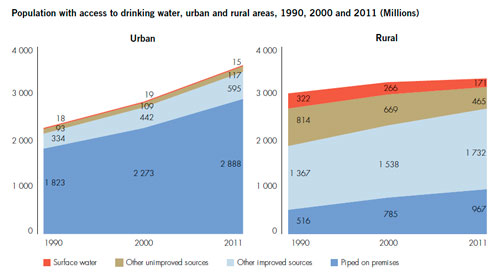
The proportion of the global population using improved sources reached 89% in 2010, up from 76% in 1990. This means that the MDG drinking water target was met. Also, over 70% of the global progress made in access to improved sources of drinking-water has been achieved through gaining access to piped drinking-water on premises. More than two thirds of the 1.5 billion people who gained access to piped supplies at home live in urban areas. Despite unprecedented progress, 768 million people still drew water from an unimproved source in 2011. 83 per cent of the population without access to an improved drinking water source (636 million) lives in rural areas.
Some 2.5 billion people still lack access to an improve sanitation facility. This means the world remains off track to meet the Millennium Development Goal (MDG) sanitation target, which requires reducing the proportion of people without access from 51% in 1990, to 25% by 2015. Even though significant progress on sanitation has been made over the years (current level of 64%), meeting the MDG target will mean extending sanitation services to an average of 660,000 people a day, every day, between 2011 and 2015.
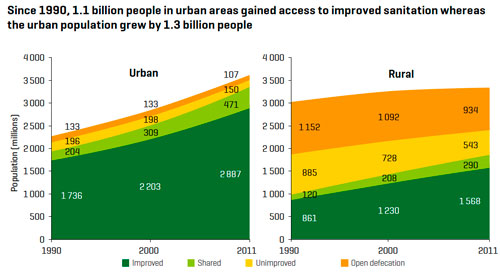
Source: Progress on Drinking Water and Sanitation: 2013 update.
WHO/UNICEF Joint Monitoring Programme, May 2013.
Plans on IWRM and water efficiency
At the World Summit on Sustainable Development in Johannesburg in 2002, countries pledged to develop Integrated Water Resources Management (IWRM) and water efficiency plans by 2005. The majority of countries did not meet this target and several attempts have been made to create an inventory to track progress.
The 2012 Status Report on the Application of Integrated Approaches to Water Resources Management contributes to the IWRM monitoring effort and concludes that:
- Since 1992, 80% of countries have embarked on reforms to improve the enabling environment for water resources management based on the application of integrated approaches as stated in Agenda 21 and affirmed in the Johannesburg Plan of Implementation.
- Water-related risks and the competition for water resources are perceived by a majority of countries to have increased over the past 20 years.
- Countries that have adopted integrated approaches report more advanced infrastructure development but further efforts are needed to ensure appropriate levels of coordination.
- Countries report a gradual but positive trend in financing for water resources development and management with more diverse sources of finance, but little progress on payment for water resources services.
- Countries report improvements to the institutional framework together with improved policies, laws and systems over the past 20 years. This has led to better water resources management practices bringing important socio-economic benefits.
- Integrated approaches to water resources management and development are critical for progress towards a green economy.
>> Water for Life Voices campaign
>> Submit your voice!
>> Your #WaterForLifeVoices on Flickr
![]() Flickr
Flickr
![]() Slideshare
Slideshare
![]() Twitter
Twitter
![]() YouTube
YouTube

>> Outcome Document from OWG on Sustainable Development Goals
>> A Post-2015 Global Goal for Water: Synthesis of key findings and recommendations from UN-Water 
>> Post 2015 Water Thematic Consultation Report
>> Report of the High-Level Panel of Eminent Persons on the Post-2015 Development Agenda
>> UN-Water section on water in the post-2015 process
>> UN post-2015 agenda
>> DESA section on Post-2015
>> JMP Post-2015 global monitoring
>> Sustainable Development Goals e-Inventory
>> Summary of Stock taking meeting of Intergovernmental Negotiations on the Post-2015 Development Agenda
>> Synthesis Report of the Secretary-General on the Post-2015 Agenda
>> Decade's weekly
The Decade's weekly brings you every week the latest news from the Decade.
>> Bimonthly Publications Review 25, 26 and 27 [ - 546 Kb]
- 546 Kb]
UNW-DPAC. May 2015
>> Previous issues
Sustainable Development
15-17 January 2015: UN-Water International Zaragoza Conference ‘Water and Sustainable Development: From vision to action’
22 March 2015: World Water Day on Water and Sustainable Development
Biodiversity
2011-2020: UN Decade on Biodiversity
Deserts and Desertification
2010-2020: UN Decade for Deserts and the Fight Against Desertification
Energy
2014-2024: Decade on Sustainable Energy for All
22 March 2014: World Water Day on 'Water and Energy'
Sanitation
2011-2015: Sustainable sanitation: The Five-Year-Drive to 2015
19 November 2014: World Toilet Day
Copyright | Terms of use | Privacy notice | Site Index | Fraud alert | Help







